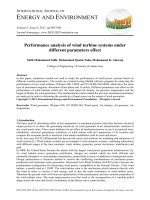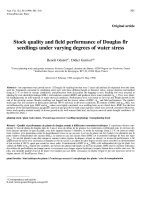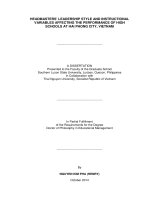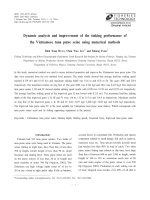Performance of growth attributes of Melia Composita wild. under different planting pattern
Bạn đang xem bản rút gọn của tài liệu. Xem và tải ngay bản đầy đủ của tài liệu tại đây (167.75 KB, 7 trang )
Int.J.Curr.Microbiol.App.Sci (2019) 8(5): 1412-1418
International Journal of Current Microbiology and Applied Sciences
ISSN: 2319-7706 Volume 8 Number 05 (2019)
Journal homepage:
Original Research Article
/>
Performance of Growth Attributes of Melia Composita Wild. under
Different Planting Pattern
Vishwajeet Sharma1*, Nikita Rai2 and Aman Kumar1
1
2
Forest Research Institute, Dehradun, India
Tropical Forest Research Institute, Jabalpur, India
*Corresponding author
ABSTRACT
Keywords
Height, Diameter,
Spacings, Melia
composita etc
Article Info
Accepted:
12 April 2019
Available Online:
10 May 2019
The present study was conducted in the stratified area of Punjab. After making a survey of
stratified areas, Hanedesra and Behera sites were selected in Punjab with three distinct
spacings i.e. 2mx2m, 3mx3m, and 4mx4m. After analyzing height and diameter data with
statistical tool of repeated measure analysis general linear model through SPSS, it has
found that the height and diameter at 3x3m spacing significantly differ from the spacing
2x2m and 4x4m spacing. While the height and diameter at 2x2m and 4x4m spacing's are
found to be non-significant. The result found significant differences at 3x3m spacing, so it
can be stated that the maximum increment in the height and diameter was recorded in
3x3m spacing.
Introduction
Melia composita Willd. belongs to family
Meliaceae. M. composita bears clean
cylindrical bole of usually 15-20 ft in height
and sometimes goes up to 40 ft with big
branches. The species originated from
southern Asia (India-Pakistan-Iran). It has
been introduced and widely cultivated in
South Africa, Middle East, America
(Bermuda, Brazil and Argentina), Australia,
South East Asia-Pacific islands, and southern
Europe. The tree requires deep red gravelly
soil, high light intensity, rainfall of about 8001000 mm and an elevation of 800-1000 mtrs.
Seedlings can tolerate frost, however, severe
frost can result in plant death. The farmers
were encouraged to plant a Melia dubia with
different agricultural crops in large scale just
because of its industrial and ecological
importance (Parthiban et al., 2009; Nuthan et
al., 2009).
At present, in India, the supply of pulpwood
is only to the pulp and paper industries.
Bamboo and reeds were the conventional raw
materials for the pulp and paper industry.
Large-scale conversion of moist deciduous
forests to plantations for economic gain and
the construction of major hydel and irrigation
projects inside the forests have led to the
depletion of raw material for pulpwood.
Competing demand by traditional industry has
also reduced their availability to pulp and
1412
Int.J.Curr.Microbiol.App.Sci (2019) 8(5): 1412-1418
paper industries. To meet the ever-growing
demand, it was found necessary to have fastgrowing species, which can yield higher
pulpwood per unit area. For this purpose,
Melia composita was found to be the best
choice. Considering the above facts,
following objectives were taken for the study,
to study the growth potential of Melia
composita under different planting patterns.
Materials and Methods
Keeping in view the above objectives, the
current study was conducted in the stratified
area of Punjab. After making a survey of
stratified areas, Hanedesra and Behera sites
were selected in Punjab with three distinct
spacing i.e.2mx2m, 3mx3m, and 4mx4m.
For collecting data of individual trees from
the field we followed different methods given
by Chaturvedi and Khanna (1984). Growth
parameters were taken into consideration for
the collection of field data such as Height of a
tree, Diameter of a tree, Current Annual
Increment, Volume of a tree and Basal Area of
a tree.
The height of standing measured from the tip
of the leading shoot (from the highest point of
the crown where there is no leader) to the
ground level and was measured with the help
of measuring tape. Diameter at breast -height
were marked by means of measuring stick on
standing trees in each plot and measured with
the help of diameter tape at 1.37 m (4 ft
6inch) above the ground level. The basal area
of a tree is usually defined as the crosssectional area at breast height. It is the square
of DBH and multiplied by a factor
0.00007854.Current
Annual
Increment
(C.A.I.) is the difference between the
dimensions measured at the beginning and at
the end of the year's growth e.g. Volume
growth.
Results and Discussion
Punjab has the best infrastructure for agro
forestry and the region is ideal for agro
forestry practices. Perusal of the data
presented in Table 1 and 2 revealed that Girth
and height in different spacing were not
significant but the repeated measure analysis
showed the significant change in height and
Girth in spacing of 3mx3m. The average data
of Girth and height of three years showed that
among three spacing at site Hanedesra (PB-1),
the average maximum Girth (45.61 cm) was
observed in 3mx3m which was statistically at
par with site Behera (PB-2) in 3mx3m
spacing i.e. (46.56cm) and the average
minimum girth was observed in spacing of
4mx4m i.e. (39.76 cm) at site Hanedesra (PB1) and 41.22 cm at site Behera (PB-2) in same
spacing of 4mx4m (Table 1 and 2). Similarly
among different spacing, the maximum
average of three years height were observed at
3mx3m spacing at Hanedesra (PB-1) i.e.
7.90m which was at par with maximum
height of 8.10 m at 3mx3m at Behera site
(PB-2). The minimum height of 6.99m was
observed in spacing 4mx4m (6.99m) at
Hanedesra (PB-1), whereas at Behera (PB-2)
site, the minimum height of 7.03m was
observed at spacing 4mx4m.
During 2014, among different spacing,
maximum plant height (7.17m) was recorded
under tree spacing of 3m×3m) at site
Hanedesra (PB-1) which was statistically at
par with same year and same spacing with a
height of 7.42m at site Behera (PB-2), and the
minimum plant height of 6.31m was recorded
in spacing of 4m×4m at site Hanedesra (PB-1)
and 6.38m at Behera (PB-2) in same spacing
(Fig. 1 and 2). Similarly the Girth recorded
among different spacings, the maximum Girth
of 40.59 cm was recorded in spacing of
3m×3m at Hanedesra (PB-1) which was at par
with same spacing and same year with a girth
of 42.78 at site Behera (PB-2). However, the
1413
Int.J.Curr.Microbiol.App.Sci (2019) 8(5): 1412-1418
minimum Girth of 36.10 cm in that year
recorded in spacing of 4m×4m at site
Hanedesra (PB-1) which was at par at same
spacing in that year with an minimum Girth
of 37.38cm in spacing of 4×4 at site Behera
(PB-2) (Fig. 1 and 2).
In the year of 2015, Height of plants under the
spacing of 3mx3m at site Hanedesra (PB-1)
gave best results with attaining a height of
7.79m while the site Hanedesra (PB-1) under
spacing of 4mx4m performed poor with
height of 7.03 m. In case of site Behera (PB2) maximum height of 8 m was observed at
same spacing of 3mx3m and the minimum
plant height of 7.02m was recorded in
Spacing of 4m×4m (Fig. 1, Table 1 and 2).
Similarly the Girth among different spacing,
maximum Girth of 45.85cm was recorded in
spacing of 3m×3m at Hanedesra (PB-1)
which was at par with same spacing of
3mx3m with a girth of 46.49 cm in same year
at site Behera(PB-2). However, the minimum
Girth of 39.88cm in that year was recorded in
spacing of 4m×4m at site Hanedesra (PB-1)
which was at par at same spacing in that year
with an minimum Girth of 40.94cm in
spacing of 4m×4m at site Behera (PB-2) (Fig.
1, 2 and Table 1, 2).
In the study period of 2016, In terms of height
among different spacing, Site Hanedesra (PB1) under spacing of 3mx3m performed best
with an attainment of maximum height of
8.73 m while it has performed poor with an
attainment of height of 7.64 m under the
spacing of 4mx4m. In case of Behera site
(PB-2) maximum plant height i.e. 8.87m was
recorded under tree spacing of (3m×3m) and
the minimum height of about 7.68 m was
observed under the spacing of 4mx4m (Fig. 1,
2 and Table 1, 2). Similarly the Girth among
different spacing, at site Hanedesra (PB-1)
maximum Girth of 50.41cm was recorded in
spacing 3m×3m which was at par with same
spacing of 3mx3m with a girth of50.42 cm in
same year at site Behera (PB-2). However, the
minimum Girth of 43.31cm in that year was
recorded in spacing of 4m×4m at site
Hanedesra (PB-1) which was at par with same
spacing in that year with a minimum Girth of
45.33cm in spacing of 4m×4m at site Behera
(PB-2) (Fig. 1, 2 and Table 1, 2).
After analyzing height and diameter data with
statistical tool of repeated measure analysis
general linear model through SPSS (Table 3).
I have found that the height and diameter at
3x3m spacing significantly differ from the
spacing 2x2m and 4x4m spacing. While the
height and diameter at 2x2m and 4x4m
spacing's are found to be non-significant. The
result found significant differences at 3x3m
spacing, so it can be stated that the maximum
increment in the height and diameter was
recorded in 3x3m spacing.
The study has shown that the growth in term
of height and diameters showing better results
in Punjab compare to Uttarakhand and
Haryana. This may be due to Punjab soil
might be good in soil nutrient for better
growth of Melia. The Melia height differs
significantly with spacing in different statutes.
But the spacing of 3m×3m showing the better
result in among all. The growth was shown
higher in Punjab this may be due availability
of soil moisture content and nutrient
availability. This can be supported by the
many studies. Soil moisture conservation
measures and nutrient management influence
plant height and collar diameter growth
(Kushalappa, 1987; Nand Kishore, 1987;
Rajendradu and Naidu, 1998; and Kopad and
Rao, 2004; Ragvendra et al., 2005).
The growth in the form of height and girths
were shown higher. The main factor might be
the combination of moisture and nutrient
availability to increases the absorption of
nutrients results in higher plant height
compared to other treatments and also might
1414
Int.J.Curr.Microbiol.App.Sci (2019) 8(5): 1412-1418
be due to the moisture balance in the plant,
which regulated the leaf shedding duration by
regulating moisture stress condition. Such
results are evidenced from Priya and Bhat
(1999), who have mentioned that these
treatments have retained the green leaf for
longer duration than the control mainly due to
prolonged meristematic activity because of
moisture availability for longer duration.
The higher plant height increment and collar
diameter increment in rainy and in dry season
were mainly due to higher moisture and
nutrient available to the plants. The lower
plant height increment and increment in
control might be due to moisture stress
experienced by the trees during growing
period. This has been supported by Anil and
Kulkarni (1995).
Maximum plant height increment and collar
diameter increment in Punjab, Uttarakhand
and Haryana was mainly attributed to higher
absorption of moisture and nutrients
supported by evidenced from Tewari (1999).
Several workers have reported that collar
diameter increment due to more soil moisture
availability (Nonhare and Chaubey, 1996).
Melia dubia could be one such alternate
indigenous fast growing multipurpose tree
species highly suitable to agroforestry
systems in India with immense potential to
serve the mankind by wide range of products
and environmental services.
It has also been demonstrated in growth
characters like tree height, diameter
(Ferguson et al., 1977; Naraynan et al., 2009;
Dlamini et al., 2017), clear bole height (Jha,
2013) and bole straightness (Vargas-Reeve et
al., 2013). Stem girth at breast height and tree
height are commonly recorded measures that
gave an idea about the tree growth. Girth at
breast height (GBH) recorded significantly
positive correlation with the tree height
similar observations were made by Tewari et
al., (2012) in Prosopis juliflora and Gupta et
al., (2012) in Acacia catechu.
An increase in diameter increment and height
might be due to higher soil moisture available
in Ring basin. Higher percent of available soil
moisture during dry season might have helped
to nutrient absorption by the plants, which in
turn resulted in higher crown diameter and
number of leaves (Nand Kishore, 1987;
Rajendradu and Naidu, 1998). It also might
have
combined
effect
of
moisture
conservation
methods
and
nutrient
management would have promoted growth
parameters possibly by way of active cell
division and elongation thereby increasing
number of branches, leaves and diameter as
reported by Gupta (1990) in Eucalyptus.
Table.1 Growth performance of Melia composita at Hanedesra, Punjab
Year
2014
2015
2016
Mean
STDEv
Age of
Plants
(Years)
2
3
4
Girth(cm)
Height
(m)
2X2
37.55
41.31
47.31
42.06
4.92
2X2
6.58
7.28
8.39
7.42
0.91
1415
Girth
Height
(cm)
(m)
Spacings (m)
3X3
3X3
40.59
7.17
45.85
7.79
50.41
8.73
45.61
7.90
4.91
0.78
Girth(cm)
Height
(m)
4X4
36.10
39.88
43.31
39.76
3.60
4X4
6.31
7.03
7.64
6.99
0.66
Int.J.Curr.Microbiol.App.Sci (2019) 8(5): 1412-1418
Table.2 Growth performance of Melia composita at Behera, Punjab
Year
Age of
Plants
(years)
Girth
(cm)
Height (m)
Girth
(cm)
Height
(m)
Girth
(cm)
Height
(m)
Spacings (m)
2X2
2X2
3X3
3X3
4X4
4X4
2014
2
36.98
6.47
42.78
7.42
37.38
6.38
2015
3
41.69
7.28
46.49
8.00
40.94
7.02
2016
4
45.94
8.23
50.42
8.87
45.33
7.68
Mean
41.54
7.33
46.56
8.10
41.22
7.03
stdev
4.48
0.88
3.81
0.73
3.97
0.64
Table.3 Repeated measure analysis (General Linear Model) statistical analysis through SPSS
Height
Diameter
Tukey HSDA,BC,
Tukey HSDa,b,c
SPACING
N
Subset
1
spacing
N
2
Subset
1
2x2
108
7.122
2x2
108
40.880
4x4
108
7.171
4x4
108
41.079
3x3
108
7.998
3x3
108
1.000
Sig.
Sig.
.917
46.090
.938
Fig.1 Height and girth growth of Melia at Hanedesra, Punjab
1416
2
1.000
Int.J.Curr.Microbiol.App.Sci (2019) 8(5): 1412-1418
Fig.2 Height and girth growth of Melia at Behera, Punjab
After analyzing height and diameter data with
statistical tool of repeated measure analysis
general linear model through SPSS, it is
concluded that the height and diameter at
3x3m spacing significantly differ from the
spacing 2x2m and 4x4m spacing. While the
height and diameter at 2x2m and 4x4m
spacing's are found to be non-significant. The
result found significant differences at 3x3m
spacing, so it can be stated that the maximum
increment in the height and diameter was
recorded in 3x3m spacing.
Acknowledgement
The authors are thankful to Shri Vedpal
Singh, Scientist, Forest Research Institute
Dehradun, Shri Pawan Kumar Punia,
Assistant Professor, UAS, Dharwad and Kapil
Sihag, Assistant Professor for providing
support during my phd research work.
References
Chaturvedi, A.N. 1984. Assessment of
biomass production. Indian Forester,
110(8): 726-738.
Kushalappa, K.A., 1987. Short note on
trenching in teak plantation, My For.,
23(1): 25-27.
Rajendradu, G., and Naidu, C. V., 1998.
Effect of water stress on leaf growth
photosynthetic and transpiration rates
of
Tectona
grandis,
Biologia
Plantarium. 40(2): 229-234.
Koppad, A.G., and Rao, R. V., 2004.
Influence
of
in-situ
moisture
conservation and methods and
fertilizer on growth of Teak (Tectona
grandis). J. Trop. Forestry Sci., 17(4):
872-874.
Raghvendra, K.N., 2005. Effect of moisture
conservation
measures
on
performance of Acacia auriculiformis
and Casurina equisetifolia, Msc
Thesis, (Unpubl), Univ. Agric. Sci.,
Dharwad (Karnataka).
Priya, P.B., and Bhat, K. M., 1999. Influence
of rainfall, irrigation and age on the
growth periodicity and wood structure
in teak (Tectona grandis). IAWAJ.
20(2): 181-192.
Anil Mohan Kumar and Kulkarani, P. K.,
1995. Improved technique of Teak.
Indian For., 4: 18.
Tewari, K.M., 1999. Prospects of poplar
plantation in Uttar Pradesh. Indian
Forester, 94(2): 163-168.
1417
Int.J.Curr.Microbiol.App.Sci (2019) 8(5): 1412-1418
Nonhare B.P., and Chaubey, O. P, 1996.
Effect of double ditch method of
planting on growth characteristics of
some forest tree species. Indian
Forester, 122(5), 366-370.
Ferguson, R.B., Land, J. R., and Cooper, D.
T. 1977. Inheritance of growth and
crown characters in American
sycamore. Silvae Genetica. 26: 5-6.
Naraynan, C., Chawhaan, P.H., and Mandal,
A.K. 2009. Inheritance Pattern of
Growth and Wood Traits in Teak
(Tectona grandis L.f.). SilvaeGenetica.
58 (3): 97-101.
Dlamini, L. N., Pipatwattanakul, D., and
Maelim, S. 2017. Growth variation
and heritability in a second-generation
Eucalyptus urophylla progeny test at
Lad Krating Plantation, Chachoengsao
province, Thailand. Agriculture and
Natural Resource. 51: 158-162.
Jha, R.K., 2013. A study of variability,
associations, and path analysis in
poplar (Populus deltoids Bartr. ex
Marsh). Journal of Sustainable
Forestry. 31(3): 185-204.
Vargas-Reeve, F., Mora, F., Perret, S., and
Scapim, C. A. 2013. Heritability of
stem
straightness
and
genetic
correlations in Eucalyptus cladocalyx
in the semi-arid region of Chile. Crop
Breeding and Applied Biology. 13(2):
107-112.
Tewari, J.C., Harsh, L. N., Sharma, N. K.,
Bohra, M. D., and Tripathi, D. 2012.
Variation and interrelations among
tree characters, pod-seed morphology
and pod biochemical characters in
Prosopis juliflora (sw) dc. Forests,
Trees and Livelihoods. 11(2): 113126.
Parthiban, K.T., Bharathi, A.K., Seenivasan,
R., Kamala, K., Rao, M.G.2009.
Integrating
Melia
dubia
in
agroforestry farms as an alternate
pulpwood species. APA News. 34:3-4.
Nuthan, D., Reddy, K. M. C., Kumar, S. P.,
Vajranabhaiah, S. N., Yogeesha, T. D.
2009. Cultivation of Melia dubia
farmlands of Kanakapura taluka
Ramanagara district of Karnataka-A
success story. Pbli. No 224, National
Afforestation and Eco-development
Board
(NAEB)
Ministry
of
Environment and Forests Government
of India University of Agricultural
Sciences, GKVK Campus Bangalore
India, RC, NAEB.
How to cite this article:
Vishwajeet Sharma, Nikita Rai and Aman Kumar. 2019. Performance of Growth Attributes of
Melia Composita Wild. under Different Planting Pattern. Int.J.Curr.Microbiol.App.Sci. 8(05):
1412-1418. doi: />
1418









